Bus
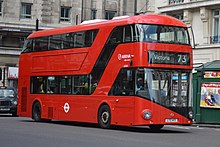
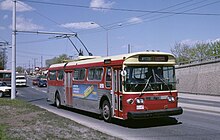
Abus(contracted fromomnibus,[1]with variantsmultibus,motorbus,autobus,etc.) is aroad vehiclethat carries significantly morepassengersthan an averagecarorvan,but less than the averagerail transport.It is most commonly used inpublic transport,but is also in use forcharterpurposes, or through private ownership. Although the average bus carries between 30 and 100 passengers, some buses have a capacity of up to 300 passengers.[2]The most common type is thesingle-deckrigid bus,withdouble-deckerandarticulated busescarrying larger loads, andmidibusesandminibusescarrying smaller loads.Coachesare used for longer-distance services. Many types of buses, such as city transit buses and inter-city coaches, charge a fare. Other types, such as elementary or secondaryschool busesorshuttle buseswithin a post-secondary education campus, are free. In many jurisdictions,bus driversrequire a speciallarge vehicle licenceabove and beyond a regulardriving licence.
Buses may be used forscheduled bus transport,scheduled coach transport,school transport,private hire, ortourism;promotional buses may be used forpolitical campaignsand others are privately operated for a wide range of purposes, including rock and pop band tour vehicles.
Horse-drawn buseswere used from the 1820s, followed bysteam busesin the 1830s, and electrictrolleybusesin 1882. The firstinternal combustion enginebuses, or motor buses, were used in 1895.[3]Recently, interest has been growing inhybrid electric buses,fuel cell buses,andelectric buses,as well as buses powered bycompressed natural gasorbiodiesel.As of the 2010s,bus manufacturingis increasinglyglobalised,with the same designs appearing around the world.
Name
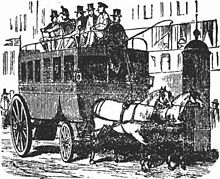
The wordbusis ashortenedform of the Latinadjectival formomnibus( "for all" ), thedativeplural ofomnis/omne( "all" ).[4]The theoretical full name is in Frenchvoiture omnibus[1]( "vehicle for all" ). The name originates from a mass-transport service started in 1823 by a French corn-mill owner namedStanislas Baudryin Richebourg, a suburb ofNantes.A by-product of his mill was hot water, and thus next to it he established aspabusiness. In order to encourage customers he started a horse-drawn transport service from the city centre of Nantes to his establishment. The first vehicles stopped in front of the shop of a hatter named Omnés, which displayed a large sign inscribed "Omnes Omnibus", a pun on his Latin-sounding surname,omnesbeing the male and female nominative, vocative and accusative form of the Latin adjectiveomnis/-e( "all" ),[4]combined withomnibus,the dative plural form meaning "for all", thus giving his shop the name "Omnés for all", or "everything for everyone".
His transport scheme was a huge success, although not as he had intended as most of his passengers did not visit his spa. He turned the transport service into his principal lucrative business venture and closed the mill and spa.[5]Nantes citizens soon gave the nickname "omnibus" to the vehicle.[1]Having invented the successful concept Baudry moved to Paris and launched the first omnibus service there in April 1828.[1]A similar service was introduced inManchesterin 1824 and in London in 1829.[6][7][8]
History
Steam buses
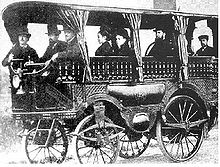
Regular intercity bus services by steam-powered buses were pioneered in England in the 1830s byWalter Hancockand by associates ofSir Goldsworthy Gurney,among others, running reliable services over road conditions which were too hazardous for horse-drawn transportation.
The first mechanically propelled omnibus appeared on the streets of London on 22 April 1833.[9]Steam carriages were much less likely to overturn, they travelled faster than horse-drawn carriages, they were much cheaper to run, and caused much less damage to the road surface due to their wide tyres.[10]
However, the heavy roadtollsimposed by theturnpike trustsdiscouraged steam road vehicles and left the way clear for the horse bus companies, and from 1861 onwards, harsh legislation virtually eliminated mechanically propelled vehicles from the roads of Great Britain for 30 years, theLocomotive Act 1861imposing restrictive speed limits on "road locomotives" of 5 mph (8.0 km/h) in towns and cities, and 10 mph (16 km/h) in the country.[11]
Trolleybuses
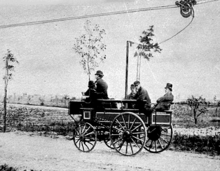
In parallel to the development of the bus was the invention of the electric trolleybus, typically fed throughtrolley polesbyoverhead wires.The Siemens brothers,Williamin England andErnst Wernerin Germany, collaborated on the development of the trolleybus concept. Sir William first proposed the idea in an article to theJournal of the Society of Artsin 1881 as an "...arrangement by which an ordinary omnibus...would have a suspender thrown at intervals from one side of the street to the other, and two wires hanging from these suspenders; allowing contact rollers to run on these two wires, the current could be conveyed to the tram-car, and back again to the dynamo machine at the station, without the necessity of running upon rails at all."[12]
The first such vehicle, theElectromote,was made by his brother Ernst Werner von Siemens and presented to the public in 1882 inHalensee,Germany.[13]Although this experimental vehicle fulfilled all the technical criteria of a typical trolleybus, it was dismantled in the same year after the demonstration.[14]
Max Schiemann opened a passenger-carrying trolleybus in 1901 nearDresden,in Germany. Although this system operated only until 1904, Schiemann had developed what is now the standard trolleybus current collection system. In the early days, a few other methods of current collection were used.LeedsandBradfordbecame the first cities to put trolleybuses into service in Great Britain on 20 June 1911.
Motor buses
InSiegerland,Germany, two passenger bus lines ran briefly, but unprofitably, in 1895 using a six-passenger motor carriage developed from the 1893Benz Viktoria.[3]Another commercial bus line using the same model Benz omnibuses ran for a short time in 1898 in the rural area aroundLlandudno,Wales.[15]
Germany'sDaimler Motors Corporationalso produced one of the earliest motor-bus models in 1898, selling a double-decker bus to the Motor Traction Company which was first used on the streets of London on 23 April 1898.[16]The vehicle had a maximum speed of 18 km/h (11.2 mph) and accommodated up to 20 passengers, in an enclosed area below and on an open-air platform above. With the success and popularity of this bus, DMG expanded production, selling more buses to companies in London and, in 1899, toStockholmandSpeyer.[16]Daimler Motors Corporation also entered into a partnership with the British company Milnes and developed a new double-decker in 1902 that became the market standard.
The first mass-produced bus model was theB-typedouble-decker bus,designed byFrank Searleand operated by theLondon General Omnibus Company—it entered service in 1910, and almost 3,000 had been built by the end of the decade. Hundreds of them saw military service on theWestern Frontduring theFirst World War.[17]
TheYellow Coach Manufacturing Company,which rapidly became a major manufacturer of buses in the US, was founded in Chicago in 1923 byJohn D. Hertz.General Motorspurchased a majority stake in 1925 and changed its name to the Yellow Truck and Coach Manufacturing Company. GM purchased the balance of the shares in 1943 to form theGM Truck and Coach Division.
Models expanded in the 20th century, leading to the widespread introduction of the contemporary recognizable form of full-sized buses from the 1950s. TheAEC Routemaster,developed in the 1950s, was a pioneering design and remains an icon of London to this day.[18]The innovative design used lightweight aluminium and techniques developed in aircraft production duringWorld War II.[19]As well as a novel weight-saving integral design, it also introduced for the first time on a busindependent front suspension,power steering,a fullyautomatic gearbox,andpower-hydraulic braking.[20]
Gallery
-
A 1911LGOC B-type
-
A 1912 Daimler CC Bus, one of five (English)Daimler Companybuses exported to Australia
Types

Formats includesingle-decker bus,double-decker bus (both usually with arigid chassis) andarticulated bus(or 'bendy-bus') the prevalence of which varies from country to country. High-capacitybi-articulated busesare also manufactured, and passenger-carrying trailers—either towed behind arigid bus(abus trailer) or hauled as a trailer by a truck (atrailer bus). Smallermidibuseshave a lower capacity andopen-top busesare typically used for leisure purposes. In many new fleets, particularly in local transit systems, a shift tolow-floor busesis occurring, primarily for easier accessibility.Coachesare designed for longer-distance travel and are typically fitted with individual high-backed reclining seats, seat belts, toilets, andaudio-visualentertainment systems, and can operate at higher speeds with more capacity for luggage. Coaches may be single- or double-deckers, articulated, and often include a separate luggage compartment under the passenger floor.Guided busesare fitted with technology to allow them to run in designated guideways, allowing the controlled alignment at bus stops and less space taken up by guided lanes than conventional roads orbus lanes.
Bus manufacturingmay be by a single company (an integral manufacturer), or by one manufacturer's building a bus body over a chassis produced by another manufacturer.
Design
Accessibility

Transit busesused to be mainlyhigh-floorvehicles. However, they are now increasingly oflow-floordesign and optionally also 'kneel'air suspensionand have ramps to provide access forwheelchairusers and people withbaby carriages,sometimes as electrically or hydraulically extended under-floor constructs for level access. Prior to more general use of such technology, these wheelchair users could only use specialistpara-transitmobility buses.
Accessible vehicles also have wider entrances and interior gangways and space for wheelchairs. Interior fittings anddestination displaysmay also be designed to be usable by thevisually impaired.Coaches generally usewheelchair liftsinstead of low-floor designs. In some countries, vehicles are required to have these features bydisability discrimination laws.
Configuration
Buses were initially configured with an engine in the front and an entrance at the rear. With the transition to one-man operation, many manufacturers moved to mid- or rear-engined designs, with a single door at the front or multiple doors. The move to the low-floor design has all but eliminated the mid-engined design, although some coaches still have mid-mounted engines. Front-engined buses still persist for niche markets such as American school buses, some minibuses, and buses in less developed countries, which may be derived from truck chassis, rather than purpose-built bus designs. Most buses have twoaxles,while articulated buses have three.[citation needed]
Guidance
Guided busesare fitted with technology to allow them to run in designated guideways, allowing the controlled alignment at bus stops and less space taken up by guided lanes than conventional roads orbus lanes.Guidance can be mechanical, optical, or electromagnetic. Extensions of the guided technology include theGuided Light TransitandTranslohrsystems, although these are more often termed 'rubber-tyred trams' as they have limited or no mobility away from their guideways.
Liveries
Transit busesare normally painted to identify the operator or a route, function, or to demarcate low-cost or premium service buses. Liveries may be painted onto the vehicle, applied using adhesivevinyltechnologies, or usingdecals.Vehicles often also carrybus advertisingor part or all of their visible surfaces (asmobile billboard).Campaign busesmay be decorated with key campaign messages; these can be to promote an event or initiative.
Propulsion
The most common power source since the 1920s has been thediesel engine.Early buses, known as trolleybuses, were powered by electricity supplied fromoverhead lines.Nowadays, electric buses often carry their own battery, which is sometimesrecharged on stops/stationsto keep the size of the battery small/lightweight. Currently, interest exists inhybrid electric buses,fuel cell buses,electric buses,and ones powered bycompressed natural gasorbiodiesel.Gyrobuses,which are powered by the momentum stored by aflywheel,were tried in the 1940s.
Dimensions
United Kingdom and European Union:
- Maximum Length: Single rear axle13.5 meters (44 ft3+1⁄2in). Twin rear axle15 meters (49 ft2+1⁄2in).
- Maximum Width:2.55 meters (8 ft4+3⁄8in)
United States, Canada and Mexico:
- Maximum Length: None
- Maximum Width:2.6 meters (8 ft6+3⁄8in)
Manufacture
Early bus manufacturing grew out of carriagecoach building,and later out of automobile or truck manufacturers. Early buses were merely a bus body fitted to a truck chassis. This body+chassis approach has continued with modern specialist manufacturers, although there also exist integral designs such as theLeyland Nationalwhere the two are practically inseparable. Specialist builders also exist and concentrate on building buses for special uses or modifying standard buses into specialised products.
Integral designs have the advantages that they have been well-tested for strength and stability, and also areoff-the-shelf.However, two incentives cause use of the chassis+body model. First, it allows the buyer and manufacturer both to shop for the best deal for their needs, rather than having to settle on one fixed design—the buyer can choose the body and the chassis separately. Second, over the lifetime of a vehicle (in constant service and heavy traffic), it will likely get minor damage now and again, and being able easily to replace a body panel or window etc. can vastly increase itsservice lifeand save the cost and inconvenience of removing it from service.[citation needed]
As with the rest of theautomotive industry,into the 20th century, bus manufacturing increasingly became globalized, with manufacturers producing buses far from their intended market to exploit labour and material cost advantages. A typical city bus costs almost US$450,000.[21]
Uses
Public transport

Transit buses,used onpublic transport bus services,have utilitarian fittings designed for efficient movement of large numbers of people, and often have multiple doors. Coaches are used for longer-distance routes. High-capacitybus rapid transitservices may use the bi-articulated bus or tram-style buses such as theWright StreetCarand theIrisbusCivis.
Buses and coach services often operate to a predetermined publishedpublic transport timetabledefining the route and the timing, but smaller vehicles may be used on more flexibledemand responsive transportservices.
Tourism

Buses play a major part in the tourism industry.Tour busesaround the world allow tourists to view local attractions or scenery. These are oftenopen-top buses,but can also be regular buses or coaches.
In localsightseeing,City Sightseeingis the largest operator of local tour buses, operating on a franchised basis all over the world. Specialist tour buses are also often owned and operated bysafari parksand othertheme parks or resorts.Longer-distance tours are also carried out by bus, either on a turn up and go basis or through atour operator,and usually allow disembarkation from the bus to allow touring of sites of interest on foot. These may be day trips or longerexcursionsincorporating hotel stays. Tour buses often carry a tour guide, although the driver or a recordedaudio commentarymay also perform this function. The tour operator may be a subsidiary of a company that operates buses and coaches for other uses or an independent company that charters buses or coaches.Commutertransport operators may also use their coaches to conduct tours within the target city between the morning and evening commuter transport journey.
Buses and coaches are also a common component of the widerpackage holidayindustry, providing private airport transfers (in addition to generalairport buses) and organised tours and day trips for holidaymakers on the package.
Tour buses can also be hired as chartered buses by groups for sightseeing at popular holiday destinations. These private tour buses may offer specific stops, such as all the historical sights, or allow the customers to choose their own itineraries. Tour buses come with professional and informed staff and insurance, and maintain state governed safety standards. Some provide other facilities like entertainment units[clarification needed],luxurious reclining seats, large scenic windows, and even lavatories.
Public long-distance coach networks are also often used as a low-cost method of travel by students or young people travelling the world. Some companies such asTopdeck Travelwere set up specifically to use buses to drive thehippie trailor travel to places such as North Africa.
In many tourist or travel destinations, a bus is part of thetourist attraction,such as the North Americantourist trolleys,London'sAEC Routemasterheritage routes,or thecustomised busesof Malta, Asia, and the Americas. Another example of tourist stops is the homes ofcelebrities,such as tours based nearHollywood.There are several such services between 6000 and 7000 Hollywood Boulevard in Los Angeles.
Student transport

In some countries, particularly the US and Canada, buses used to transport schoolchildren have evolved into a specific design with specified mandatory features. American states have also adopted laws regarding motorist conduct around school buses, including large fines and possibly prison for passing a stopped school bus in the process of loading or offloading children passengers. Theseschool busesmay haveschool bus yellowlivery andcrossing guards.Other countries may mandate the use ofseat belts.As a minimum, many countries require a bus carrying students to display asign,and may also adopt yellow liveries. Student transport often uses older buses cascaded from service use, retrofitted with more seats or seatbelts. Student transport may be operated by local authorities or private contractors. Schools may also own and operate their own buses for other transport needs, such as classfield tripsor transport to associated sports, music, or other school events.
Private charter
Due to the costs involved in owning, operating, and driving buses and coaches, much bus and coach use comes from the private hire of vehicles from charter bus companies, either for a day or two or on a longer contract basis, where the charter company provides the vehicles and qualified drivers.

Charter bus operators may be completely independent businesses, or charter hire may be a subsidiary business of a public transport operator that might maintain a separate fleet or use surplus buses, coaches, and dual-purpose coach-seated buses. Many privatetaxicabcompanies also operate largerminibusvehicles to cater for group fares. Companies, private groups, and social clubs may hire buses or coaches as a cost-effective method of transporting a group to an event or site, such as a group meeting,racingevent, or organised recreational activity such as asummer camp.Schools often hire charter bus services on regular basis for transportation of children to and from their homes. Chartered buses are also used by education institutes for transport toconventions,exhibitions, andfield trips.Entertainment or event companies may also hire temporary shuttles buses for transport at events such as festivals orconferences.Party busesare used by companies in a similar manner tolimousinehire, for luxury private transport to social events or as a touring experience.Sleeper busesare used by bands or other organisations that tour between entertainment venues and require mobile rest and recreation facilities. Some couples hire preserved buses for their wedding transport, instead of the traditional car. Buses are often hired forparadesorprocessions.Victory paradesare often held for triumphant sports teams, who often tour their home town or city in anopen-top bus.Sports teams may also contract out their transport to a team bus, for travel toaway games,to acompetitionor to afinal event.These buses are often specially decorated in a livery matching the team colours. Private companies often contract out private shuttle bus services, for transport of their customers or patrons, such as hotels,amusement parks,university campuses,orprivate airport transferservices. This shuttle usage can be as transport between locations, or to and fromparking lots.High specification luxury coaches are often chartered by companies forexecutiveorVIPtransport. Charter buses may also be used in tourism and for promotion (See Tourism and Promotion sections).
Private ownership
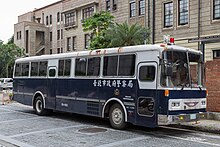
Many organisations, including the police,not for profit,social or charitable groups with a regular need for group transport may find it practical or cost-effective to own and operate a bus for their own needs. These are oftenminibusesfor practical, tax and driver licensing reasons, although they can also be full-size buses.Cadetorscoutgroups or other youth organizations may also own buses. Companies such as railroads, construction contractors, and agricultural firms may own buses to transport employees to and from remote job sites. Specific charities may exist to fund and operate bus transport, usually using specially modified mobility buses or otherwise accessible buses (See Accessibility section). Some use their contributions to buy vehicles and provide volunteer drivers.
Airport operators make use of special airsideairport busesfor crew and passenger transport in the secureairsideparts of an airport. Some public authorities, police forces, and military forces make use ofarmoured buseswhere there is a special need to provide increased passenger protection. TheUnited States Secret Serviceacquired two in 2010 for transporting dignitaries needing special protection.[22]Police departmentsmake use ofpolice busesfor a variety of reasons, such asprisoner transport,officertransport, temporary detention facilities, and ascommand and control vehicles.Somefire departmentsalso use a converted bus as a command post[23]while those in cold climates might retain a bus as a heated shelter at fire scenes.[24]Many are drawn from retired school or service buses.
Promotion
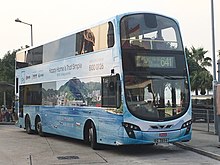
Buses are often used for advertising,political campaigning,public information campaigns,public relations,orpromotionalpurposes. These may take the form of temporary charter hire of service buses, or the temporary or permanent conversion and operation of buses, usually ofsecond-handbuses. Extreme examples include converting the bus with displays and decorations orawningsand fittings. Interiors may be fitted out for exhibition or information purposes with special equipment oraudio visualdevices.
Bus advertising takes many forms, often as interior and exterior adverts and all-over advertising liveries. The practice often extends into the exclusive private hire and use of a bus to promote a brand or product, appearing at large public events, or touring busy streets. The bus is sometimes staffed by promotions personnel, giving out free gifts.Campaign busesare often specially decorated for apolitical campaignor other social awareness information campaign, designed to bring a specific message to different areas, or used to transport campaign personnel to local areas/meetings. Exhibition buses are often sent to public events such asfairsand festivals for purposes such as recruitment campaigns, for example by private companies or thearmed forces.Complexurban planningproposals may be organised into a mobile exhibition bus for the purposes of public consultation.
Goods transport
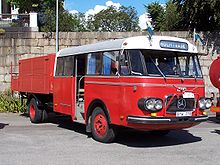
In some sparsely populated areas, it is common to use brucks, buses with a cargo area to transport both passengers and cargo at the same time. They are especially common in theNordic countries.
Around the world

Historically, the types and features of buses have developed according to local needs. Buses were fitted with technology appropriate to the local climate or passenger needs, such as air conditioning in Asia, orcyclemounts on North American buses. The bus types in use around the world where there was little mass production were often sourced secondhand from other countries, such as theMalta bus,and buses in use in Africa. Other countries such as Cuba required novel solutions to import restrictions, with the creation of the "camellos" (camel bus), a specially manufacturedtrailer bus.
After the Second World War, manufacturers in Europe and the Far East, such asMercedes-Benz busesandMitsubishi Fusoexpanded into other continents influencing the use of buses previously served by local types. Use of buses around the world has also been influenced by colonial associations or political alliances between countries. Several of theCommonwealth nationsfollowed the British lead and sourced buses from British manufacturers, leading to a prevalence ofdouble-decker buses.SeveralEastern Bloccountries adopted trolleybus systems, and their manufacturers such asTrolzaexported trolleybuses to other friendly states.[citation needed]In the 1930s, Italy designed the world's only[dubious–discuss]triple decker bus for the busy route between Rome and Tivoli that could carry eighty-eight passengers. It was unique not only in being a triple decker but having a separate smoking compartment on the third level.[25]
The buses to be found in countries around the world often reflect the quality of the local road network, with high-floor resilient truck-based designs prevalent in several less developed countries where buses are subject to tough operating conditions. Population density also has a major impact, where dense urbanisation such as in Japan and the far east has led to the adoption of high capacity longmulti-axle buses,often double-deckers while South America and China are implementing large numbers ofarticulated busesforbus rapid transitschemes.
Bus expositions
Euro Bus Expo is atrade show,which is heldbienniallyat the UK'sNational Exhibition Centrein Birmingham. As the official show of theConfederation of Passenger Transport,the UK's trade association for the bus, coach and light rail industry, the three-day event offers visitors from Europe and beyond the chance to see and experience the very latest vehicles and product and service innovations right across the industry.
Busworld Kortrijk inKortrijk,Belgium, is the leading bus trade fair in Europe. It is also held biennially.
Use of retired buses
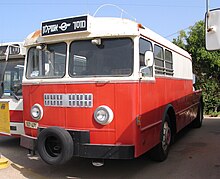
Most public or private buses and coaches, once they have reached the end of their service with one or more operators, are sent to thewrecking yardfor breaking up forscrapandspare parts.Some buses which are not economical to keep running as service buses are often converted for use other than revenue-earning transport. Much like old cars and trucks, buses often pass through adealershipwhere they can be bought privately or at auction.
Bus operators often find it economical to convert retired buses to use as permanenttraining busesfor driver training, rather than taking a regular service bus out of use. Some large operators have also converted retired buses into tow bus vehicles, to act astow trucks.With the outsourcing of maintenance staff and facilities, the increase in companyhealth and safetyregulations, and the increasingcurb weightsof buses, many operators now contract their towing needs to a professionalvehicle recoverycompany.

Some buses that have reached the end of their service that are still in good condition are sent for export to other countries.
Some retired buses have been converted to static or mobile cafés, often using historic buses as atourist attraction.There are also catering buses: buses converted into a mobilecanteenandbreak room.These are commonly seen at externalfilming locationsto feed the cast and crew, and at other large events to feed staff. Another use is as an emergency vehicle, such as high-capacityambulance busor mobilecommand centre.
Some organisations adapt and operateplaybusesor learning buses to provide aplaygroundor learning environments to children who might not have access to proper play areas. An ex-LondonAEC Routemasterbus has been converted to a mobile theatre andcatwalk fashion show.[26]
Some buses meet a destructive end by being entered inbanger racesor atdemolition derbies.A larger number of old retired buses have also been converted into mobile holiday homes and campers.
Bus preservation
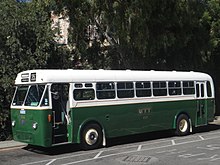
Rather than beingscrappedor converted for other uses, sometimes retired buses are saved for preservation. This can be done by individuals, volunteer preservation groups or charitable trusts, museums, or sometimes by the operators themselves as part of aheritage fleet.These buses often need to berestoredto their original condition and will have their livery and other details such as internal notices androllsignsrestored to be authentic to a specific time in the bus's history. Some buses that undergo preservation are rescued from a state of great disrepair, but others enter preservation with very little wrong with them. As with other historic vehicles, many preserved buses either in a working or static state form part of the collections oftransport museums.Additionally, some buses are preserved so they can appear alongside other period vehicles in television and film. Working buses will often be exhibited at rallies and events, and they are also used as charter buses. While many preserved buses are quite old or even vintage, in some cases relatively new examples of a bus type can enter restoration. In-service examples are still in use by other operators. This often happens when a change in design or operating practice, such as the switch to one person operation or low floor technology, renders some buses redundant while still relatively new.
Modification as railway vehicles
See also
References
- ^abcdChisholm, Hugh,ed. (1911)..Encyclopædia Britannica.Vol. 20 (11th ed.). Cambridge University Press. p. 104.
- ^"China's longest bus unveiled in Shanghai".Jongo.com. 15 March 2007. Archived fromthe originalon 30 September 2011.
- ^abEckermann, Erik (2001),World History of the Automobile,SAE, pp. 67–68,ISBN9780768008005,retrieved6 October2013
- ^abMarchant, J.R.V.; Charles, Joseph F., eds. (1928).Cassell's Latin Dictionary(Revised ed.).
- ^"La préhistoire des transports urbains"[The prehistory of urban transport] (in French). Chelles, Seine-et-Marne, France: Transportation Museum.Archivedfrom the original on 22 March 2021.Retrieved22 February2019.
- ^Fierro 1996,p. 1031.
- ^"Omnibus (n.)".Online Etymology Dictionary.Archivedfrom the original on 7 September 2017.Retrieved30 March2013.
- ^"Histoire générale des transports"(in French). French transportations Museum Website. Archived fromthe originalon 18 July 2011.Retrieved16 September2010.
- ^"Centenarxy of the Omnibus".The Times.28 April 1933. p. 16.
- ^Benson, Bruce L. "The Rise and Fall of Non-Government Roads in the United Kingdom".Street Smart: Competition, Entrepreneurship and the Future of Roads.pp. 263–264.
- ^"Locomotives Act, 1861".Pratt's Law of Highways(10th ed.). Shaw & Sons. 1865. p. 388.
- ^"Trolleybus history – current collector design".Archivedfrom the original on 4 May 2011.Retrieved6 October2013.
- ^ElektromoteArchived29 July 2016 at theWayback Machine,Siemens History website. Retrieved 2011-08-28
- ^Charles S. Dunbar,Buses, Trolleys and Trams,(Paul Hamlyn Ltd, 1967, no ISBN) p. 81et seq.
- ^Ward, Ian (1974),The World of Automobiles: An Illustrated Encyclopedia of the Motor Car,vol. 15, Orbis, p. 1773
- ^ab"1898: The world's first bus series launched by Daimler – a milestone for passenger transport – marsMediaSite".Archivedfrom the original on 26 April 2021.Retrieved29 August2016.
- ^Robbins, G. J.; Atkinson, J. B. (1991).The London B-Type Motor Omnibus(3rd ed.). Twickenham: World of Transport.ISBN1-871979-04-8.
- ^"AEC Southall Enthusiast page".Aecsouthall.co.uk.Archivedfrom the original on 31 January 2020.Retrieved19 April2013.
- ^"The Bus We Loved book description, 12 September 2006".Londonbooks.co.uk. Archived fromthe originalon 21 February 2014.Retrieved6 October2013.
- ^Routemaster.orgArchived2 September 2011 at theWayback Machinehome page
- ^Gross, Daniel (5 September 2014)."Further".Slate.The Slate Group.Archivedfrom the original on 12 July 2017.Retrieved5 September2014.
- ^Robert Farley (25 August 2011)."Obama's Canadian-American Bus".FactCheck.Archivedfrom the original on 25 May 2017.Retrieved17 October2011.
- ^"Chesapeake Fire Department".Cityofchesapeake.net. 1 May 1998. Archived fromthe originalon 21 November 2010.Retrieved12 October2010.
- ^City of Winnipeg Corporate Web Services."Winnipeg Fire Department".Winnipeg.ca. Archived fromthe originalon 6 January 2010.Retrieved12 October2010.
- ^Hearst Magazines (August 1932)."Three Decker Auto Bus Carries 88 Persons".Popular Mechanics.Hearst Magazines. p. 286.Archivedfrom the original on 15 April 2021.Retrieved1 November2015.
- ^Event preview: Fashion Bus On The Square, LondonArchived23 June 2021 at theWayback MachineThe Guardian,16 August 2008
Bibliography
- Combeau, Yvan (2013).Histoire de Paris.Paris: Presses Universitaires de France.ISBN978-2-13-060852-3.
- Fierro, Alfred (1996).Histoire et dictionnaire de Paris.Robert Laffont.ISBN2-221-07862-4.
- Héron de Villefosse, René (1959).Histoire de Paris.Bernard Grasset.
External links
- American Bus Association(Archived7 February 2011 at theWayback Machine)




